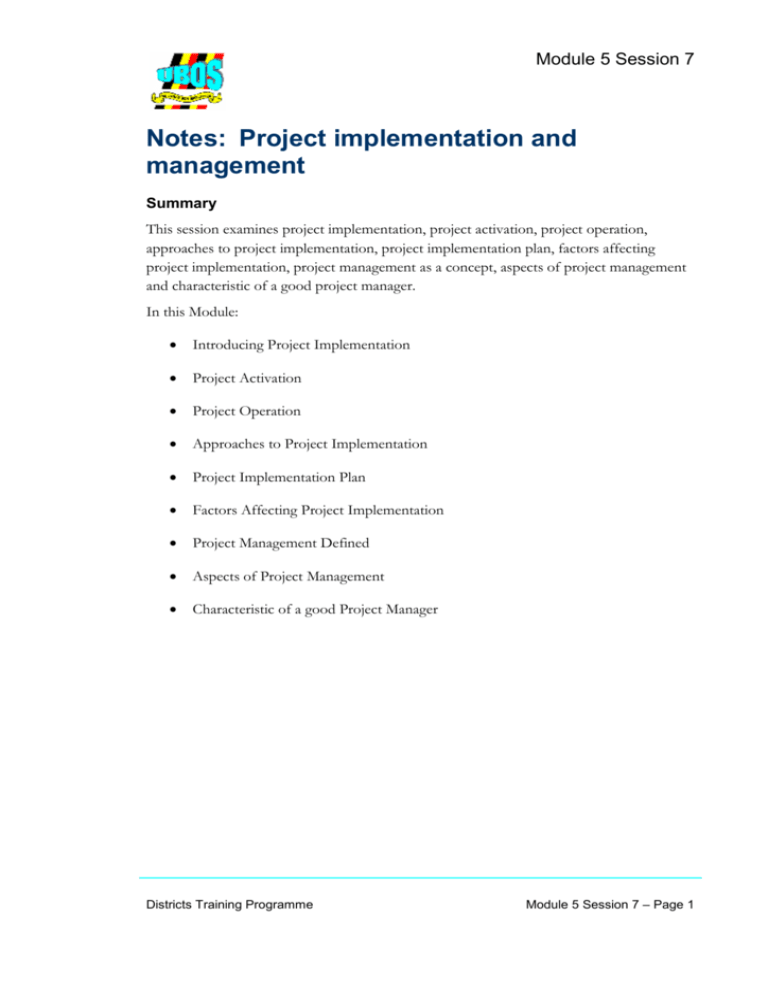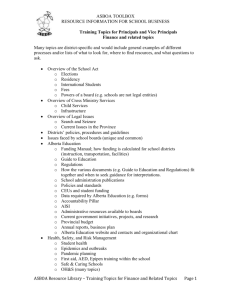Notes: Project Implementation & Management
advertisement

Module 5 Session 7 Notes: Project implementation and management Summary This session examines project implementation, project activation, project operation, approaches to project implementation, project implementation plan, factors affecting project implementation, project management as a concept, aspects of project management and characteristic of a good project manager. In this Module: Introducing Project Implementation Project Activation Project Operation Approaches to Project Implementation Project Implementation Plan Factors Affecting Project Implementation Project Management Defined Aspects of Project Management Characteristic of a good Project Manager Districts Training Programme Module 5 Session 7 – Page 1 Module 5 Session 7 Introduction After preparing the project document, it is presented to the probable financier (funding agency). This is followed by project appraisal, selection, negotiation and finally approval. Approval means that the funding agency has accepted in principle to finance the project. At this level, the financial agreements are concluded and project implementation begins thereafter. Project implementation can be referred to as a process whereby “project inputs are converted to project outputs as set out in the project framework”. The process involves a series of activities, which need to be planned, operated and controlled, and which will inevitably involve the utilization of resources. The management of these activities is fundamental to a supervisor or monitor so that the project can be completed on time and at cost consistent with the project plan. Project implementation may be looked at as: Putting in action the activities of the project. Putting into practice what was proposed in the project document i.e. transforming the project proposal into the actual project. Management of the project or executing the project intentions. Project, implementation is carried out following the already laid down timetable or work plan. It leads to the realization of project outputs and immediate objectives. Project implementation is usually done by the organization that prepared the project and received funding for it. This organization is referred to as the implementing agency. The implementing agency sets up a project implementation unit, which carries out the implementation on behalf of the implementing agency. Other organizations that participate in the implementation of the project by way of collaboration say by according good working relationship, extending some technical advice or seconding their staff to the project, are referred to as Co-operating agencies. Example: If a given sub-county is to implement a sanitation project, the departments of water, community development and health will act as cooperating agencies. The project implementation phase involves: Project activation and Project operation Districts Training Programme Module 5 Session 7 – Page 2 Module 5 Session 7 Project Activation Project activation simply means making arrangements to have the project started. It is the preliminary or foundation stage of project implementation and it involves the coordination and allocation of resources (funds, labor and materials) to make the project operational. The following activities are undertaken during project activation Establishment of Project Implementation Units (PIUs) Recruitment of project manager and other staff Tendering and procurement of machines, equipment and other suppliers Preparation of contingency plans Designation of the internal project authorities for decision making and establishment of communication channels Putting in place staff training and development programmes and code of conduct Setting up linkages with the target group Location and negotiation of sites Project Operation Project operation is also referred to as the development and normal life period of the project. It is the actual management of a project in practical terms. This is the level when the project inputs are transformed into outputs via the project activities following the laid down work plan. This leads to the attainment of immediate objectives. It involves the coordinating, monitoring and control of the performance of the various project groups and the use of project resources in such a way that the project activities are completed in an orderly and optimal fashion within the constraint of time and resources available. Operation and maintenance In order to attain value from the project and get maximum returns on the investment the district/municipality or the beneficiaries organize for the facility to be used properly and maintained regularly. An operation and maintenance manual will be prepared by the contractor and handed to the district. Approaches to Project Implementation Top-Down Approach In this approach, the implementation is mainly done by agencies from outside the community with limited involvement by the beneficiaries. These agencies come with their own staff and workers. They may include Government departments or ministries, international development agencies. Districts Training Programme Module 5 Session 7 – Page 3 Module 5 Session 7 This approach is good for projects that require quick results like relief projects, as there is limited time to involve the target group. The disadvantage with this approach is that it may result into passivity, hostility and resistance by the beneficiaries. When it succeeds, it makes the beneficiaries develop a dependence syndrome and lack of capacity building of the human resources and sustainability of the project. Bottom-Up Approach In this approach the beneficiaries implement the project. The outside agencies may provide the financial resources and possibly technical assistance. The advantages with this approach are that: Capacity is built within the community The project is readily acceptable There is increased use of local resources including labor The beneficiaries learn to be self-reliant leading too project sustainability Collaborative Participatory Approach This is when the aspects of both top-down and bottom-up approaches to project implementation are applied in the implementation process. A case in point is when a CBO is implementing a dairy project and say the Government seconds a veterinarian to offer technical assistance by way of offering the needed veterinary services. Project Implementation Plan If not carried out during the project design process and embodied in the project document, it is carried out at the project activation stage. It includes among others: The Project Implementation Schedule What activities will be undertaken to produce the expected project outputs? What is the sequence of these activities? What is the time frame for these activities? Who will be responsible for carrying out each activity? The following methods may be used to answer the above questions: The Gantt chart The Critical Path Method (CPM) or Net work analysis Project Evaluation and Review Techniques (PERT) Simple formats Districts Training Programme Module 5 Session 7 – Page 4 Module 5 Session 7 The Gantt chart The Gantt chart is also referred to as the progress chart. It is a chart showing the timing of project activities using horizontal bars. It is one of the techniques of project scheduling, which depicts the frequency of activities and determines the period of time for implementation. How to determine a Gantt chart Determine the parts or implementation phases of the project and the sequence in which the associated activities shall be carried out Then estimate the amount of time required for each activity List the activities that can be carried out at the same time and identify those to be carried out sequentially How to construct the Gantt chart Time represented on the horizontal axis, and activities on the vertical axis. Bars are entered to indicate the time period allocated for each activity and the state of progress at any particular point in time. Example: Maize farming project Activity Marketing Threshing Harvesting Weeding Planting Preparing seedbed 0 Jan Feb. Mar. Apr. May Jun. Jul. Aug. Time period in months Districts Training Programme Module 5 Session 7 – Page 5 Module 5 Session 7 It is a useful source of information to the supervisor or monitor who may not have the time to read lengthy documents It enables the supervisor to identify and report achievements within the project period The Simple Format Activity Starting date Ending date Cost Responsible person Remarks Preparing seed bed Planning Weeding Harvesting Storage Threshing Marketing The Role of the Implementing Agency In the implementation plan the role that the implementing organization (agency) is to play is spelt out e.g. contribution of resources (financial, material and human). The specific responsibilities of the key staff during project implementation and monitoring are outlined. The form, quantity and timing of inputs are also discussed. Districts Training Programme Module 5 Session 7 – Page 6 Module 5 Session 7 Beneficiary Participation The involvement of the beneficiaries in planning and implementation and what they are expected to contribute is spelt out. Organizational Structure and Staffing Here answers to the following questions are sought How is the project going to be structured for purposes of management? What are the required qualifications and skills for the staff? What are the job descriptions and specifications for the staff? In case there is no local qualified staff has technical assistance been provided for? Financial Management How are the project funds to be managed? E.g. finance committee. What is going to be the accounting period? E.g. 1st January to 31st December. What basic financial reports and statements will be made? E.g. quarterly reports, income statement, balance sheet, audit reports etc. How often will they be made? E.g. monthly, quarterly, annually etc. Reporting System Who will be reporting to whom and how often? There is need to design standard reporting formats. Sustainability The concept of sustainability is based on the belief that project implementation should result in benefits that have a lasting effect and as such the project should be sustained beyond and the life of the funding especially if it is a grant. Again the project should not exhaust the available resources like raw materials and labor. A project is said to be sustainable if: Its products or services meet the needs of the local community It generates some income and becomes self-reliant financially It protects the environment It uses locally available resources and appropriate technology It meets the needs of the present without jeopardizing the ability of future generations to meet their needs Time control and remedial action The time taken to implement project activities is an important measure of successfulness of supervision or monitoring of project implementation among others. The supervisor pays Districts Training Programme Module 5 Session 7 – Page 7 Module 5 Session 7 particular attention to time control measures, time scheduling and its supervision, time extension and postponement, damages for non-completion and defect or warranty period. Time is a major supervision function of project implementation. When a project implementation runs out of time, it develops strain and puts an additional stress on resources from the various parties to sustain the extension. On almost every party involved, there is additional operational expenditure. To the LG in addition to the above, it means loss of revenue that would have been generated or saved if the project had been implemented as planned or delay of service delivery. Time element and value Project implementation time deals with setting and start, duration and end phases of a project implementation process. These three characteristics have got special values individually and collectively. There are events and activities in project implementation that must either start or take a certain specific duration or end on certain dates. The time frame developed thus is known as the critical path. Any operations outside this critical path will lead to possibilities of poor quality, extra costs, delays and losses. Time related delays in project implementation would be controlled by: Planning and setting targets Choosing the right work plan or programme Monitoring and evaluating progress in a timely manner Taking immediate corrective action Time scheduling Time scheduling is the assigning of start dates and completion dates to the various activities that take place in project implementation. The important points to note are: The earliest time that an activity can start The latest time that an activity may be completed without delaying the project completion The leeway or float or degree of freedom available in scheduling an activity The resultant critical path NB Most often he supervisor does not develop the time schedule directly but instructs the contractor to prepare it. It is the contractor’s plan, not supervisor’s. The supervisor checks and advises the district or municipality whether it is realistic and achievable within the available means. Districts Training Programme Module 5 Session 7 – Page 8 Module 5 Session 7 Supervision of implementation of project schedule This involves a set of checks and balances to ensure that the schedule is being adhered to. To ensure that the time schedule is being adhered to, the project activity time listing below can be of great importance: Table: Project Activity Time Listing Activity Activity Activity Activity Activity latest Progress Code Description duration earliest time time remark Start Finish Start Finish In supervision of project implementation time, the most troublesome aspects are matters of claims for time related extra costs and extensions of time by the contractor and the disputes that result there from. The supervisor of project implementation needs to protect the interest of the district. Factors Affecting Project Implementation They are of two categories: those that lead to the success of the project and those retard or lead to the failure of the project. Districts Training Programme Module 5 Session 7 – Page 9 Module 5 Session 7 Factors that lead to success of projects a) Political Commitment Political or government commitment is the continuing interest and active support of those agencies and individuals who are in a position to influence the attainment of the project’s objectives, whether through the allocation of human and financial resources or through the working of the administrative and political apparatus. For the success of any project, sustained commitment by the Government to the projects is a pre-requisite. b) Simplicity of Design Projects with relatively simple and well-defined objectives and based on proven and appropriate technologies or approaches have good chance of being implemented successfully. c) Careful preparation Projects need to be implemented after they have been sufficiently prepared d) Good management Successfully implemented projects are associated with good managers and as such sound project management is a key to project success. The influence of the quality of management on project performance is always visible. Many projects in serious difficulty during implementation have been turned around by the appointment of a competent manager, just as performance in others has noticeably declined when a good manager has departed. In summary, there is no simple formula for the success of projects. Each project faces a unique set of circumstances, many of which can be foreseen and controlled but some of which cannot. Effective project planning, design and implementation are at the heart of successful projects. It their presence cannot always guarantee success, their absence is almost certain to lead to failure. Factors and problems that lead to failure of projects a) Financial Problems These include: Pressure on the cost side because of the general wage and price increases Difficulties in raising prices, taxes and interest rates Losses due to fluctuations in foreign exchange rates b) Management problems Districts Training Programme Module 5 Session 7 – Page 10 Module 5 Session 7 Managerial or institutional problems are usually the root cause of implementation delays and cost overruns. Other project management problems include; Lack of competent local project Managers Insufficient capacity of local suppliers and contractors Lack of a proper management information system Unnecessary bureaucracy in project administration A corrupt project management Delays in delivery of project inputs Inadequate personnel training, high personnel turnover, poor choice of personnel and frequent rotation of personnel c) Technical problems These include: Poor quality materials and machinery Technical defects in design of equipments leads to quick failure. Mistakes in the installation and start-up of equipment. Late arrival of machinery. Unsuitability of imported equipment for local conditions (inappropriate technology). Difficult or unexpected soil conditions e.g. using a tractor in a wetland. d) Political problems Even in the absence of such oblivious disruptions as war and internal upheavals, political problems are the major causes of the difficulties experienced by projects. When political/government commitment is absent, weak or variable, project implementation suffers. Political pressure affects the location of projects. Other typical implementation problems Poor scheduling of projects leading to delays in implementation. Delay in disbursement of project funds Misallocation of funds Delay and sometimes lack of counterpart funding Lack of accountability and transparency by project managers and other implementers. Bureaucracy in decision-making. Selfishness/nepotism/favoritism by some project managers. Weak monitoring systems Natural calamities like drought, earthquakes, landslides, and hailstorms. Policy changes Districts Training Programme Module 5 Session 7 – Page 11 Module 5 Session 7 Migration of beneficiaries Lack of team work Lack of incentives for implementers. Etc Project Management Management defined Management may be defined as: Taking control, taking charge or directing Getting things done from the available resources, the way you want them to be done. These resources are Human, Financial, Physical and informational Process of planning and decision making, organizing and leading and controlling and organization’s human, financial, physical and information resources to achieve organizational goals in an efficient and effective manner Process of working with and through others to achieve organizational objectives in a changing environment Project management defined Project Management is an all-embracing term covering the management of every detail of a project (Project cycle) and may be defined as, “the process of planning and directing a project from its inception to its final completion in a given time as at a given cost for a given end product.” Project Control Management decision determines what the project is to be; project planning determines how the project is to be run and project control determines the actual running of the project. Management decision This is a necessary function for the setting up of a project. It is concerned with: (i) Forecasting: This is an attempt to look into the future. You carry out investigations and interpret the facts and make conclusions. (ii) Objectives: Forecasts must be transferred into objectives at every level in order to progress in an orderly manner. Managers must set the main objectives, which will guide the subordinates at every level. Districts Training Programme Module 5 Session 7 – Page 12 Module 5 Session 7 (iii) Policy: Policy statements provide a standing answer to questions and are the key to delegation. Work will proceed much more smoothly and rapidly if anticipated problems are solved in advance, especially if they are of a repetitive nature. Planning Planning determines the success or failure of the project. It has three (3) main aspects: (i) Programming: The programme is a sequence of activities in the project. It depends upon the forecasts, objectives and policies to a great extent. Many points will be answered as the programme is built up, as it is not possible to foresee every eventually. (ii) Scheduling: A schedule sets the time limits for the various activities and follows the process of programming. It is at this stage that the standards of performance become very important (iii) Budgeting: Budgets are the means of ensuring that the most economical use is made of resources such as money, labor, materials, machinery, space and time. The final control of a project will depend upon accurate budgeting and prompt measurement of progress. The process of planning is continuous, calling for constant revision as new problems arise. Project Control To control is to compare actual with planned (budgeted) achievements and to take action to correct any adverse deviations. The principle of project control is to achieve the stated objectives in accordance with the predetermined plan. So one of the Manager’s tasks is to exercise tight control at all times because performance rarely matches the plan. Aspects of project control include: i) Plans of Operation: These are the result of the planning process of Project Management. ii) Review and Updating: No plan of operation, however accurate, can encompass all the contingencies that may arise during the course of a project. Therefore continual review is necessary to determine whether the project is proceeding according to plan or how much behind or a head of plan it is. Updating is the process of recording the state of the project as shown by the reviews, or of making amendments. Districts Training Programme Module 5 Session 7 – Page 13 Module 5 Session 7 iii) Action When review has shown a project to be deviating from plan, action is required to restore the operation to its planned characteristics. Extra work or additional resources, or other means available to the Manager may achieve this. Alternatively, the action taken may be to review the plan in the light of the development. Characteristics of a Good Project Manager A good Project Manager : Should have working knowledge in several fields Should be able to understand general managerial problems Should have active interest in training and developing subordinates Should be able to delegate some of the tasks to subordinates Should know the project and understand its objectives Should know the systematic process for managing projects Should be able to provide answers to the following questions o What is the project for? o Why is it required? o Whom does it serve? o How is it justified? o How is it going to be used? Districts Training Programme Module 5 Session 7 – Page 14








